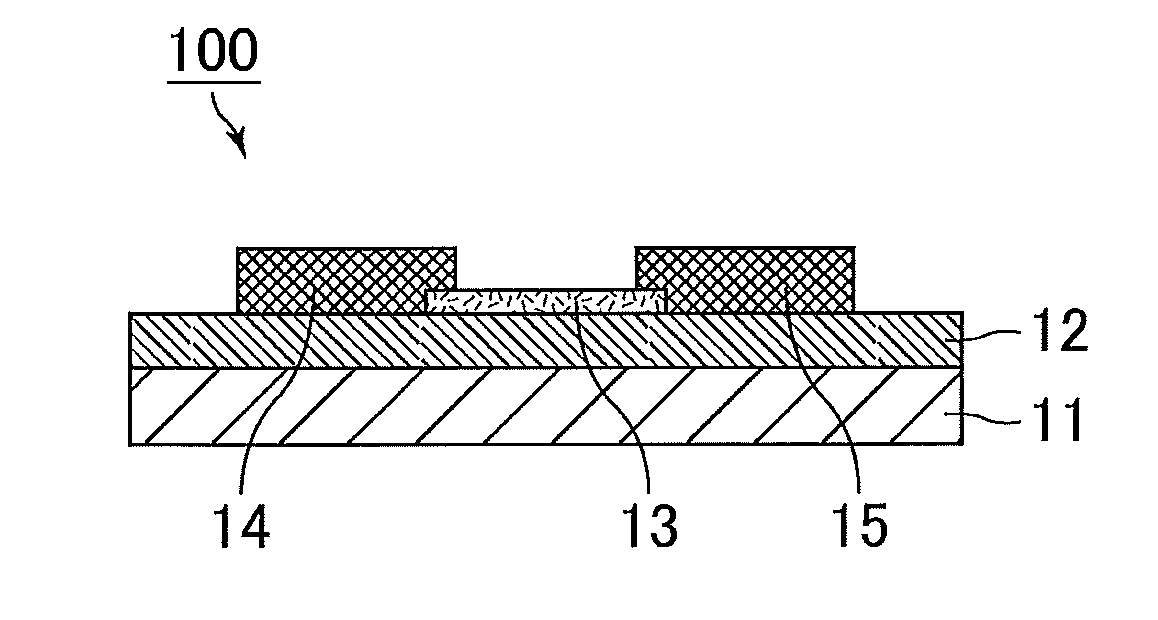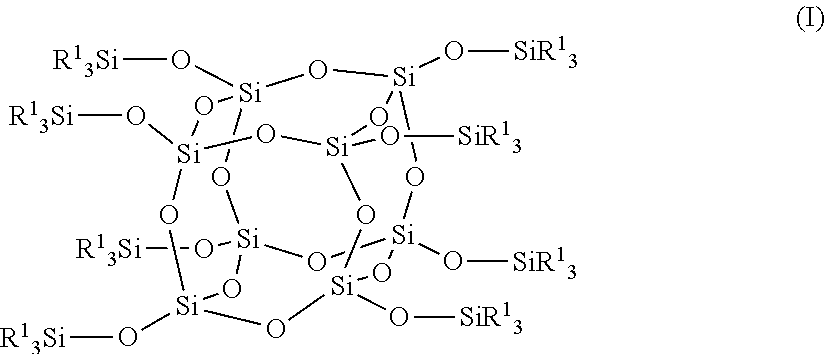Positive photosensitive composition, thin film transistor, and compound
a technology of thin film transistors and compositions, applied in the direction of photomechanical devices, instruments, semiconductor/solid-state device details, etc., can solve the problems of not developing positive photosensitive compositions whose cure products satisfy the insulation properties required for insulating films, and lack of sufficient insulation properties for use as insulating films, etc., to achieve excellent electrical insulation reliability, excellent patterning properties, excellent transistor performance and reliability
- Summary
- Abstract
- Description
- Claims
- Application Information
AI Technical Summary
Benefits of technology
Problems solved by technology
Method used
Image
Examples
synthesis example 1
[0300]A 100-mL four-neck flask was charged with 20 g of toluene and 3 g of 1,3,5,7-tetramethylcyclotetrasiloxane. The gas phase of the flask was purged with nitrogen and the mixture was then heated to an inner temperature of 100° C. and stirred. A liquid mixture of 5 g of the reactant (1) synthesized by the above process, 0.7 mg of a platinum vinylsiloxane complex in xylene (containing 3% by weight of platinum), and 5 g of toluene was added dropwise to the flask.
[0301]After the dropwise addition, the absence of the peak derived from allyl group was confirmed by 1H-NMR. Toluene was then evaporated under reduced pressure to give a clear and colorless liquid “reactant A”. By 1H-NMR measurement, the resulting product was confirmed to be a polysiloxane compound that had a bisphenol S structure protected with trimethylsilyl groups and contained 6.0 mmol / g of SiH groups as determined using dibromoethane as a standard and expressed in equivalents.
synthesis example 2
[0302]A 100-mL four-neck flask was charged with 20 g of toluene and 3 g of 1,3,5,7-tetramethylcyclotetrasiloxane. The gas phase of the flask was purged with nitrogen and the mixture was then heated to an inner temperature of 100° C. and stirred. A liquid mixture of 5 g of the reactant (1) synthesized by the above process, 0.7 mg of a platinum vinylsiloxane complex in xylene (containing 3% by weight of platinum), and 5 g of toluene was added dropwise to the flask.
[0303]After the dropwise addition, the absence of the peak derived from allyl group was confirmed by 1H-NMR. The temperature inside the flask was set to 80° C. and 1 g of vinylcyclohexene was added thereto. After the addition, the absence of the peak derived from vinyl group was confirmed by 1H-NMR. Toluene was then evaporated under reduced pressure to give a clear and colorless liquid “reactant B”. By 1H-NMR measurement, the resulting product was confirmed to be a polysiloxane compound that had a bisphenol S structure prote...
synthesis example 3
[0304]A 100-mL four-neck flask was charged with 20 g of toluene and 3 g of 1,3,5,7-tetramethylcyclotetrasiloxane. The gas phase of the flask was purged with nitrogen and the mixture was then heated to an inner temperature of 100° C. and stirred. A liquid mixture of 5 g of the reactant (2) synthesized by the above process, 0.7 mg of a platinum vinylsiloxane complex in xylene (containing 3% by weight of platinum), and 5 g of toluene was added dropwise to the flask.
[0305]After the dropwise addition, the absence of the peak derived from allyl group was confirmed by 1H-NMR. Toluene was then evaporated under reduced pressure to give a clear and colorless liquid “reactant C”. By 1H-NMR measurement, the resulting product was confirmed to be a polysiloxane compound that had a bisphenol A structure protected with trimethylsilyl groups and contained 6.0 mmol / g of SiH groups as determined using dibromoethane as a standard and expressed in equivalents.
PUM
| Property | Measurement | Unit |
|---|---|---|
| wavelength | aaaaa | aaaaa |
| photosensitive | aaaaa | aaaaa |
| temperature | aaaaa | aaaaa |
Abstract
Description
Claims
Application Information
 Login to View More
Login to View More - R&D
- Intellectual Property
- Life Sciences
- Materials
- Tech Scout
- Unparalleled Data Quality
- Higher Quality Content
- 60% Fewer Hallucinations
Browse by: Latest US Patents, China's latest patents, Technical Efficacy Thesaurus, Application Domain, Technology Topic, Popular Technical Reports.
© 2025 PatSnap. All rights reserved.Legal|Privacy policy|Modern Slavery Act Transparency Statement|Sitemap|About US| Contact US: help@patsnap.com



